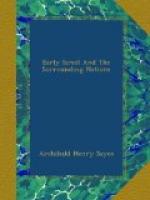Along with the reformation in religion had gone a reformation in art. The old conventionalised art of Egypt was cast aside, and an attempt was made to imitate nature, exactly, even to the verge of caricature. The wall and floor paintings that have been discovered at Tel el-Amarna are marvels of realistic art. Plants and animals and birds are alike represented in them with a spirit and faithfulness to nature which is indeed astonishing. Like the houses of his followers, the palace of the king was adorned with similar frescoes. But it was also decorated with a lavish profusion of precious materials; its walls and columns were inlaid with gold and bronze and precious stones, statues almost Greek in their type stood within it, and even its stuccoed floors were covered with costly paintings. Roads were made in the desert eastward of the city, where its wealthier inhabitants took their morning drives, and the king occupied the earlier part of the clay in giving lectures or sermons on the articles of his faith.
The archives of the empire had been transferred from Thebes to the new capital. Among them was the foreign correspondence, written upon clay tablets in the cuneiform characters, and (for the most part) in the language of Babylonia. We have learnt from it that the Babylonian language and script were the common means of intercommunication from the Euphrates to the Nile in the century before the Exodus. It proves how long and how profound must have been the influence and rule of Babylonia in western Asia. Throughout the civilised world of Asia the educated classes were compelled to learn a foreign writing and language, and when the empire passed from Babylonia to Egypt, Egypt itself, whose script and literature went back to immemorial times, was forced to do the same. The correspondence was active and far-reaching. There are letters in it from the kings of Babylonia and Assyria, of Mitanni and Cappadocia, as well as from the Egyptian governors in Canaan. Even Bedawin shekhs take part in it, and the letters are sometimes on the most trivial of subjects. It is clear that schools and libraries must have existed throughout the civilised East, where the Babylonian characters could be taught and learned, and where Babylonian literature and official correspondence could be stored up. Among the tablets found at Tel el-Amarna are some fragments of Babylonian literature, one of which has served as a lesson-book, and traces of dictionaries have also been discovered there.




